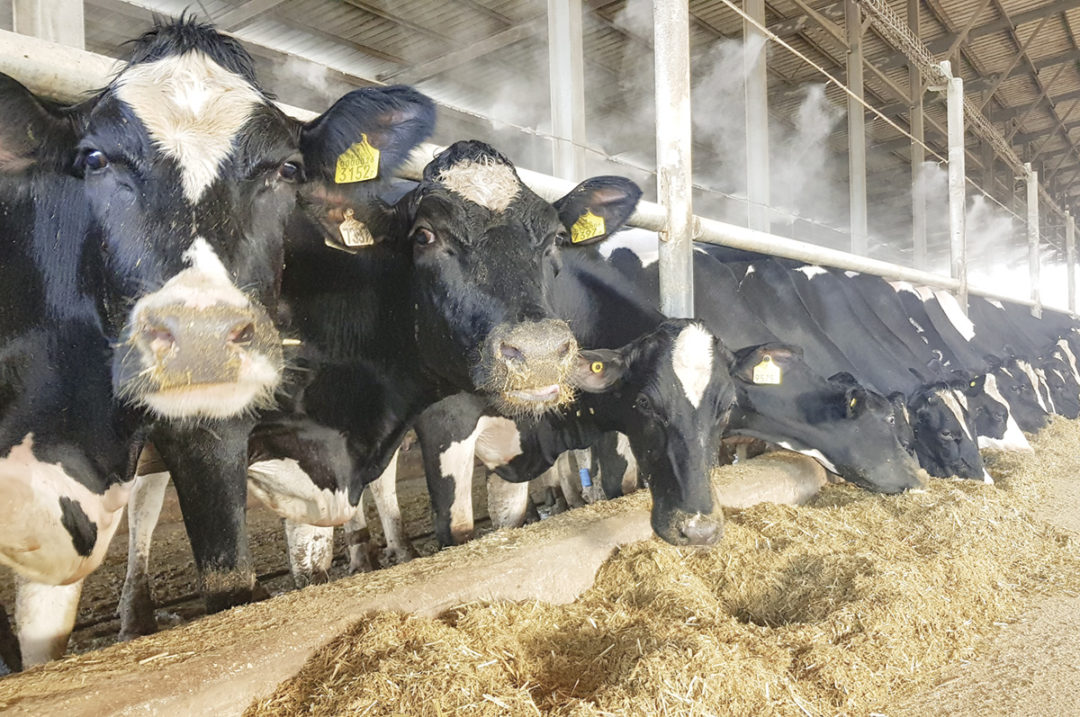Over the past few years, heat stress management has become a hot topic for dairy producers. Global warming is contributing to continuous heat waves, even in countries where they have been uncommon previously. Here in Israel, it is notoriously hot during the summer, with temperatures reaching 122°F (50°C) in certain parts of the country. As a result of climate change, it is increasingly important for dairy farms to alter management techniques so high production can be maintained.
How do dairy cows react to heat stress?
Dairy cows are vulnerable to heat stress. As temperatures rise, so does a cow’s body temperature and respiratory rate as she pants to cool down. Heat stress can reduce feed and water consumption, decrease rumination and movement, and drop daily milk yield as a cow strives to conserve energy. These physiological changes negatively impact health and productivity, underscoring the importance of management strategies like shade, cool water and adequate ventilation, to mitigate heat stress and ensure the well-being of these animals.
The value of cow comfort
Our priority is to provide our cows with a comfortable and pleasant environment. If we fail to do this, milk production will suffer. Reduced fertility rates are also highly correlated with heat stress. This double whammy translates into a decrease in revenue on our profit and loss statement.
Early warning signs
As temperatures rise, be on the lookout for signs of heat stress, such as increased body temperatures (over 102.2°F or 30°C), elevated respiratory rates (over 70 per minute), reduced milk yield, decreased food and water consumption, and decreased rumination and movement (Figure 1).

Early detection is key
Early detection of heat stress in dairy cows enables quick intervention, mitigating its adverse effects on well-being and productivity.
Heat stress is now available as a protocol for herd management software. Few herd management companies provide early detection systems. An early warning would be sent to the farm manager based on parameters they can measure as part of the heat stress scoring process. Consider implementing one of the available systems in your area.
Actions we often take in Israel
Israeli dairy farmers have long taken proactive steps to cool cows during the summer. The effort is now becoming more necessary worldwide.
There are several effective methods Israeli dairy farmers use to reduce heat stress on the farm. A key is to ensure adequate space per cow. Heat stress management is more effective when we give each cow the right amount of space – at least 22 square feet per cow.
We have found success managing heat by creating a cooling cycle that considers these two concepts:
- Heat is transferred from a cow to water through thermal conduction.
- Heat is transferred from water to the environment by thermal convection (the dominant form of heat transfer in liquids and gases).
The first step is to enable the transfer of heat from the cow to water. We do this by applying water onto her back using a sprinkler system. Sprinklers are situated 6.5 to 8 feet (2 to 2.5 meters) above the ground, depending on sprinkler type. We aim for a height that ensures water drops are distributed evenly to penetrate the cow's hair coat.
The second step is to disperse, or convection, the water into the air. We accomplish this by creating wind with a forced ventilation system. This requires gusts of wind so the current air can be displaced with the new air.
This setup uses a combination of several types of ventilation systems, including a high-volume, low-speed (HVLS) fan, aka helicopter fan. The 24-foot diameter of this fan can move the necessary volume of air up to 22,000 square feet, essentially pushing the air across the barn. Within the cooling room, we use much stronger fans.

Cows cooling off in the waiting room in the very hot Kibbutz Kalia in Israel, near the Dead Sea. Courtesy photo.
Create a special cooling room
We create a special room to conduct the cooling session, commonly called a cooling shed. It can be situated anywhere that makes sense, even in the holding pen. To ensure success, the room must be equipped with the right equipment. For the lactating cows, we use the waiting room as the cooling room.
Depending on the weather, cooling cycles may be performed several times a day. When it is hot, we start a new cooling cycle every time the top hair on the cows dries.
Cow comfort outside the parlor and holding pen
While the holding pen is a prime target for excessive heat generation, it is not the only place cows become overheated. Pay attention to other areas of the facility to ensure heat stress is not an issue. As mentioned before, ensuring each cow has the right amount of space goes a long way in preventing heat stress.
In Israel, the HVLS fan is essential. Additionally, we also incorporate foggers near bunks and water troughs.
Cow comfort is a win-win for everyone
Though we can do little to reverse global warming, we can impact what happens on our farms. We are charged with providing our cows with a comfortable environment. A heat stress management system should be planned and implemented to give our herd what it needs to thrive despite the heat.
According to my colleague, Dr. Israel Flamenbaum, investing in cooling systems and running them is the most profitable return on investment in Israel and now, across the world. A cooling investment pays for itself within two years, making it a very viable investment.
Taking advantage of the cooling systems available in your area is highly recommended.
Langer owns Israeli Dairy School, providing practical training for global companies and organizations.








